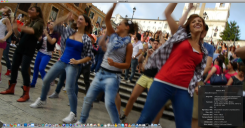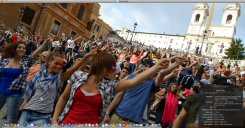
-
@LPowell yes, I know there's a lot of motion blur, but for example in the first pic look at the arm over the sky: it's blurred but there are a lot of compression blocks. Or look at the orange/brown wall behind: looks more like a low compressed JPEG rather than motion blur, same thing on the edges of check-patterned shirts. I mean... wait! For a 800 euros camera this is still wonderful, I know that I don't have a RED Epic in my hands (LOL!) ... I'm just asking for something impossible, right? ;P ... by the way you you should be proud of your amazing job: all my friends who shoots with canons got impressed when they saw my GH2 performing much better on this project than their 5Ds!
I'll upload the mts as soon as I can, I don't have a fast connection right now.
-
@LPowell sorry for the delay. I've attached an uncompressed screenshot. This week we shot a flashmob and since reliability was a must I used FM 2.0.2, the camera never froze but you can see a lot of compression artifacts and visible blocks around fast moving parts which I've never seen on Driftwood's Mysteron (I've just opened a similar project on my mac shot on that gop1 hack to seek the same compression artifacts, but I know it's not fair, I'm gonna plan a side by side comparison with another GH2 and these two hacks). On the other hand the firmware never crashed which was my main goal for this event and I think I'm gonna keep your FM for a long time : )
The footage is 25P 1080 HBR - 160 ISO - Lumix 14-140 - 1/50 f/8 on Lexar Professional 32Gb 400x (60MB/s)

 screenshot_flashmob.png1920 x 1002 - 3M
screenshot_flashmob.png1920 x 1002 - 3M
 screenshot_flashmob2.png1919 x 1002 - 3M
screenshot_flashmob2.png1919 x 1002 - 3M -
@LPowell is it possible that two copies of GH2 have slightly different sensors? Or a bit different response to the firmware? I currently have two GH2 bodies, one with FloMo v 2.02, another Sanity v5. The one with FloMo keeps looking sharper and more contrasty, for sure. I swapped the lenses but the result is still the same: Sanity seems to "brighten" the shadows, while FloMo gives, IMHO, better defined shadows (I see more detail), and also a bit punchier (more contrast.)
-
@Botvinic. People like @LPowell, @driftwood, @RalpB and others put weeks of work to make GH2 a better camera. They are doing it with the best of their knowledge and limitations of the camera capabilities. There are plenty of options to choose from. You don't like one, pick another that fits your need better. I don't know if it is a language problem or not but you are in no position to make such offensive remarks and demands of these guys like you are paying them for what they do. You are more than welcome to provide feedback for their settings but to demand that they fix it for you after they have explained the reason is ludicrous. If there was a way to fix it, they would have done it already. Please have some respect. It annoys the rest of us who read these posts.
-
@LPowell Okay.
Why in other settings, shadows - good. And then - the dirt? So the problem in your settings :) I want those shadows http://www.personal-view.com/talks/uploads/FileUpload/e4/2071415771e37fc063005b9b9f9be1.png
You can do special for us (me and charlie_orozco) settings to "correct" :) shadows? Special Flow Motion, Lol.
-
@Botvinic do you think other medium/lower bit rate patch will do a better job on this difficult exposure situation? I have a few doubts about it after testing many of them in the last months. Btw, this kind of scene could be a good scenario to test different patches(of course not too scientific considering the change of light)but yet.
-
@Botvinic The second clip is not an example of properly-exposed Flow Motion footage. It is an attempt to salvage the severely underexposed areas of the first clip. If you can contribute more sophisticated post-production salvaging techniques, I'd be interested to learn from your examples.
-
@Botvinic Coarse encoding at extremely low light levels is not a "bug", it's an inherent shortcoming of the AVCHD encoder's 4:2:0 color depth. @charlie_orozco helpfully sent me his original test footage and permitted me to embed it here. I think it's a very good example of one of the most difficult shooting situations, a high-contrast scene with near-black shadow details. What's challenging is that enhancing the shadows in this case involves not only a technical gamma correction - it needs something of an artistic touch to render the coarsely encoded data in a naturalistic manner.
The problematic issue with shadow details is that the image sensor resolves them as full-color RGB data, where it should really be desaturating the shadows as they fade into black. In preserving over-saturated hues of shadow areas, the camera fails to account for the fact that to the human eye, pure blues and purples appear much darker than other shades that may be recorded at the same illumination levels. With care, this undesirable psycho-visual effect can often be corrected in post.
One the most significant distinctions in Flow Motion v2 is how it smoothes out low-level chroma noise while fully preserving luminance detail, both in shadows and highlights. This makes the AVCHD encoder behave more like the way human vision works: high-resolution perception of contrast combined with low-resolution perception of color.
Here is the original GH2 Flow Motion v2 test footage with near-black shadow details:
I used Adobe After Effects CS5.5 to produce this color-graded version with enhanced shadow details. No filters were used to add or remove shadow noise from the video:
-
@driftwood & @LPowell I just tested Crossfire variation 2 'Green Screen matrix' set to 24h. It looks good but it shows up as 24fps in after effects not 23.98
-
http://www.personal-view.com/talks/discussion/comment/66160#Comment_66160
This is a very big bug! How do I fix this? I want to use FM. I like stability.
-
@towi Shouldn't do. These settings relate to Time_Scale in the AVCHD standard. time_scale is the number of time units that pass in one second. For example, a time coordinate system that measures time using a 27 MHz clock has a time_scale of 27 000 000. time_scale shall be greater than 0.
This relates to Num_Clock_Ticks. So long as the transport stream time scale is greater than 0 all should be fine.
If you analyse a AVCHD header, in the PPS set you should be able to see the results of GOPx2 time under time_scale.
Howdy, Stranger!
It looks like you're new here. If you want to get involved, click one of these buttons!
Categories
- Topics List23,992
- Blog5,725
- General and News1,354
- Hacks and Patches1,153
- ↳ Top Settings33
- ↳ Beginners256
- ↳ Archives402
- ↳ Hacks News and Development56
- Cameras2,367
- ↳ Panasonic995
- ↳ Canon118
- ↳ Sony156
- ↳ Nikon96
- ↳ Pentax and Samsung70
- ↳ Olympus and Fujifilm101
- ↳ Compacts and Camcorders300
- ↳ Smartphones for video97
- ↳ Pro Video Cameras191
- ↳ BlackMagic and other raw cameras116
- Skill1,960
- ↳ Business and distribution66
- ↳ Preparation, scripts and legal38
- ↳ Art149
- ↳ Import, Convert, Exporting291
- ↳ Editors191
- ↳ Effects and stunts115
- ↳ Color grading197
- ↳ Sound and Music280
- ↳ Lighting96
- ↳ Software and storage tips266
- Gear5,420
- ↳ Filters, Adapters, Matte boxes344
- ↳ Lenses1,582
- ↳ Follow focus and gears93
- ↳ Sound499
- ↳ Lighting gear314
- ↳ Camera movement230
- ↳ Gimbals and copters302
- ↳ Rigs and related stuff273
- ↳ Power solutions83
- ↳ Monitors and viewfinders340
- ↳ Tripods and fluid heads139
- ↳ Storage286
- ↳ Computers and studio gear560
- ↳ VR and 3D248
- Showcase1,859
- Marketplace2,834
- Offtopic1,320










